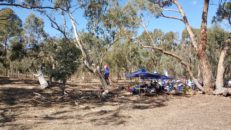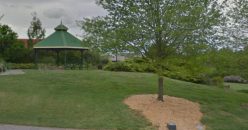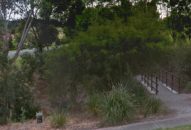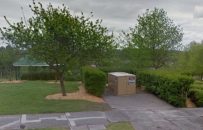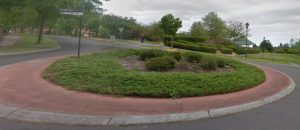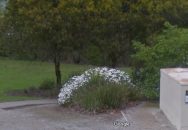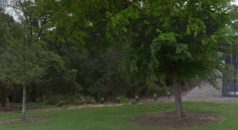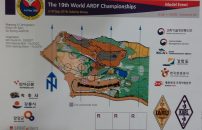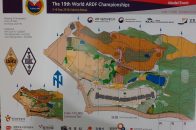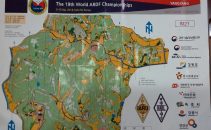With the forecast wind and hail, 9 brave souls attempted the ARDF Sprint training held in and around Deakin Uni. A couple also did some of the Enduro controls, which was an orienteering event starting from the same spot.

The format of the event was a Five-in-Five 2m event, which in theory is possible to complete in about 6.5 minutes, followed immediately by an 80m Sprint ARDF event. Five-in-Five uses classic 5 minute cycle (1 minute each) ARDF transmitters spaced close enough that it should be possible, walking, to get to each transmitter as it comes on first time (for you). Only Jack WWW managed to get the transmitters in under 10 minutes (2 cycles). Good effort, Jack ! He admits he had a bit of luck, with earlier competitors just leaving transmitters as he approached, helping to lead him in. The time limit for this part of the event was set to 30 minutes. The transmitters were all in parkland, just off a track. In you look at the splits, below, you’ll also see Jack was the only one to do the transmitters in order, with everyone else going from #1 to #5, and then to others. Perhaps some just happened across #5 by accident ?
Mark, Suzanne & Rodney elected to only do the Five-in-Five course, with Mark the winner amongst those. Suzanne suffered some late penalties (problems with #1), but still beat out Rodney for second place. Looking at the splits at control 6 (236), Jack was clearly the fastest at this part of the event, followed with an impressive 11 minutes by Jenelle.
An ARDF sprint event has a 1 minute complete cycle, with each transmitter only on for 12s each. This was set in an area with both complex buildings, the university, and parkland around Gardiners Creek. TX #5 and #4 were in amongst the buildings and this proved too much for Jack and Peter, but not so Kris and Jennelle, who both managed those with ease. Monica liked #5 so much she punched it twice (see splits below) ! Clearly after being so flustered by those two tricky TX’s, Jack and Peter both also forgot to punch the Finish Beacon (which you are required to do at international events).
And TX #1 in the uni accommodation area ? Well, it had to be there didn’t it 🙂 Can’t make it too easy ! Generally competitors had to plan and DF carefully in this event, as it could be easy to end up the wrong side of the creek. Competitors doing both events had an un-timed (up to a 10min limit) transition leg between 2m and 80m, to get their 80m gear in order. I’m happy to say the software handled this perfectly, and I didn’t have to adjust the times it published at all.
Yep, we got that hail, and the heavy rain, but luckily both were only for short bursts, being perfect running conditions otherwise. Monica says the hail even helped her spot TX#5, as she sought shelter under cover. Besides, it’s good practice and testing for your gear, as sometimes weather can be quite unpredictable at international events. Torrential downpours are not uncommon. Thanks to Ewen for the new 80m Sprint TXs. Proto TX#1 for the 2m set has now been completed (and works), so soon we’ll have a 6-TX set on both bands.
Thank you to everyone who helped pick up the transmitters afterwards, just before the rain came (again). Apologies to Monica for not giving her a key on her first attempt.
Here’s the map, with TX locations shown. I’ve used A->E for the 80m TX, and 1->5 for 2m TX. BB was the location of both 2m and 80m beacons.

Here’s the full results:
| Name |
Callsign |
Course |
#TX |
Score |
Late Penalty |
Time |
Place |
|
1 |
Time |
2 |
Time |
3 |
Time |
4 |
Time |
5 |
Time |
6 |
Time |
|
|
|
|
|
|
|
|
|
|
|
|
|
|
|
|
| Mark |
VK3BES |
FiveInFive |
6 |
51 |
0 |
22:24:00 |
1 |
|
231 |
11:17:00 |
232 |
12:15:00 |
235 |
14:17:00 |
234 |
19:42:00 |
233 |
21:45:00 |
236 |
22:49:00 |
|
|
|
|
|
|
|
|
|
|
|
|
|
|
|
|
| Suzanne |
VK3FSZI |
FiveInFive |
6 |
24 |
27 |
38:39:00 |
2 |
|
231 |
17:40:00 |
232 |
18:57:00 |
233 |
23:24:00 |
234 |
32:43:00 |
235 |
36:17:00 |
236 |
39:06:00 |
|
|
|
|
|
|
|
|
|
|
|
|
|
|
|
|
| Rodney |
VK3FRLS |
FiveInFive |
13 |
20 |
0 |
20:53:00 |
3 |
|
231 |
01:28:00 |
235 |
02:44:00 |
|
|
|
|
|
|
|
|
|
|
|
|
|
|
|
|
|
|
|
|
|
|
|
|
|
|
|
|
|
|
|
|
|
1 |
Time |
2 |
Time |
3 |
Time |
4 |
Time |
5 |
Time |
6 |
Time |
7 |
Time |
8 |
Time |
9 |
Time |
|
Time |
11 |
Time |
12 |
Time |
13 |
Time |
14 |
Time |
| Kristian |
VK3FDAC |
FullSprint |
13 |
102 |
0 |
39:11:00 |
1 |
|
231 |
01:16:00 |
235 |
03:39:00 |
234 |
05:07:00 |
232 |
12:18:00 |
233 |
13:25:00 |
236 |
14:06:00 |
37 |
15:45:00 |
33 |
19:24:00 |
31 |
24:25:00 |
32 |
28:49:00 |
34 |
33:23:00 |
35 |
40:13:00 |
36 |
41:18:00 |
|
|
| Jenelle |
VK3FJTE |
FullSprint |
13 |
102 |
0 |
47:25:00 |
2 |
|
231 |
01:21:00 |
235 |
03:13:00 |
233 |
06:17:00 |
232 |
07:12:00 |
234 |
09:18:00 |
236 |
10:53:00 |
37 |
14:40:00 |
34 |
27:46:00 |
35 |
31:46:00 |
32 |
37:11:00 |
33 |
45:30:00 |
31 |
48:15:00 |
36 |
51:38:00 |
|
|
| Ewen |
VK3OW |
FullSprint |
13 |
102 |
0 |
69:51:00 |
3 |
|
231 |
01:17:00 |
235 |
05:46:00 |
233 |
11:08:00 |
232 |
11:49:00 |
234 |
14:23:00 |
236 |
15:59:00 |
37 |
17:48:00 |
33 |
20:37:00 |
31 |
25:19:00 |
32 |
30:53:00 |
34 |
40:53:00 |
35 |
69:21:00 |
36 |
71:57:00 |
|
|
| Monica |
VK3FFAB |
FullSprint |
13 |
102 |
0 |
74:25:00 |
4 |
|
231 |
01:20:00 |
235 |
10:35:00 |
232 |
12:12:00 |
233 |
14:03:00 |
234 |
14:36:00 |
236 |
15:50:00 |
37 |
22:50:00 |
35 |
27:48:00 |
32 |
35:04:00 |
34 |
43:50:00 |
33 |
68:04:00 |
31 |
76:13:00 |
36 |
79:52:00 |
35 |
27:51:00 |
| Jack |
VK3WWW |
FullSprint |
13 |
81 |
0 |
43:09:00 |
5 |
|
231 |
01:26:00 |
232 |
02:46:00 |
233 |
03:52:00 |
234 |
04:42:00 |
235 |
05:32:00 |
236 |
07:44:00 |
37 |
09:53:00 |
31 |
16:05:00 |
32 |
21:10:00 |
33 |
43:52:00 |
|
|
|
|
|
|
|
|
| Peter |
Val |
FullSprint |
13 |
81 |
0 |
74:24:00 |
6 |
|
231 |
12:01:00 |
235 |
13:39:00 |
232 |
17:16:00 |
233 |
18:44:00 |
234 |
19:49:00 |
236 |
21:23:00 |
37 |
23:57:00 |
33 |
47:57:00 |
31 |
52:24:00 |
32 |
60:16:00 |
|
|
|
|
|
|
|
|


